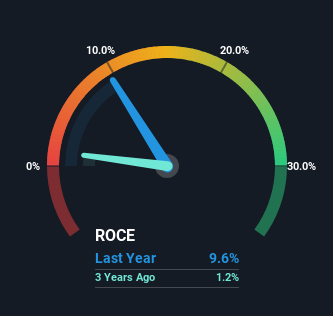Returns On Capital Are Showing Encouraging Signs At Elgi Rubber (NSE:ELGIRUBCO)
There are a few key trends to look for if we want to identify the next multi-bagger. Ideally, a business will show two trends; firstly a growing return on capital employed (ROCE) and secondly, an increasing amount of capital employed. Put simply, these types of businesses are compounding machines, meaning they are continually reinvesting their earnings at ever-higher rates of return. Speaking of which, we noticed some great changes in Elgi Rubber's (NSE:ELGIRUBCO) returns on capital, so let's have a look.
What Is Return On Capital Employed (ROCE)?
If you haven't worked with ROCE before, it measures the 'return' (pre-tax profit) a company generates from capital employed in its business. To calculate this metric for Elgi Rubber, this is the formula:
Return on Capital Employed = Earnings Before Interest and Tax (EBIT) ÷ (Total Assets - Current Liabilities)
0.096 = ₹282m ÷ (₹5.7b - ₹2.7b) (Based on the trailing twelve months to March 2024).
Thus, Elgi Rubber has an ROCE of 9.6%. In absolute terms, that's a low return and it also under-performs the Machinery industry average of 18%.
View our latest analysis for Elgi Rubber

While the past is not representative of the future, it can be helpful to know how a company has performed historically, which is why we have this chart above. If you want to delve into the historical earnings , check out these free graphs detailing revenue and cash flow performance of Elgi Rubber.
How Are Returns Trending?
Elgi Rubber has broken into the black (profitability) and we're sure it's a sight for sore eyes. While the business was unprofitable in the past, it's now turned things around and is earning 9.6% on its capital. While returns have increased, the amount of capital employed by Elgi Rubber has remained flat over the period. That being said, while an increase in efficiency is no doubt appealing, it'd be helpful to know if the company does have any investment plans going forward. So if you're looking for high growth, you'll want to see a business's capital employed also increasing.
On a separate but related note, it's important to know that Elgi Rubber has a current liabilities to total assets ratio of 48%, which we'd consider pretty high. This effectively means that suppliers (or short-term creditors) are funding a large portion of the business, so just be aware that this can introduce some elements of risk. Ideally we'd like to see this reduce as that would mean fewer obligations bearing risks.
Our Take On Elgi Rubber's ROCE
To bring it all together, Elgi Rubber has done well to increase the returns it's generating from its capital employed. Since the stock has returned a staggering 194% to shareholders over the last five years, it looks like investors are recognizing these changes. In light of that, we think it's worth looking further into this stock because if Elgi Rubber can keep these trends up, it could have a bright future ahead.
On a final note, we found 4 warning signs for Elgi Rubber (2 shouldn't be ignored) you should be aware of.
While Elgi Rubber isn't earning the highest return, check out this free list of companies that are earning high returns on equity with solid balance sheets.
Valuation is complex, but we're here to simplify it.
Discover if Elgi Rubber might be undervalued or overvalued with our detailed analysis, featuring fair value estimates, potential risks, dividends, insider trades, and its financial condition.
Access Free AnalysisHave feedback on this article? Concerned about the content? Get in touch with us directly. Alternatively, email editorial-team (at) simplywallst.com.
This article by Simply Wall St is general in nature. We provide commentary based on historical data and analyst forecasts only using an unbiased methodology and our articles are not intended to be financial advice. It does not constitute a recommendation to buy or sell any stock, and does not take account of your objectives, or your financial situation. We aim to bring you long-term focused analysis driven by fundamental data. Note that our analysis may not factor in the latest price-sensitive company announcements or qualitative material. Simply Wall St has no position in any stocks mentioned.
About NSEI:ELGIRUBCO
Elgi Rubber
Manufactures and sells reclaimed rubber, retreading machinery, and retread rubber in India and internationally.
Slightly overvalued with imperfect balance sheet.
Similar Companies
Market Insights
Community Narratives



